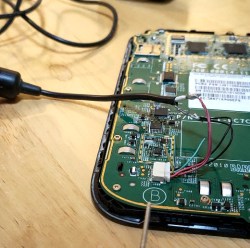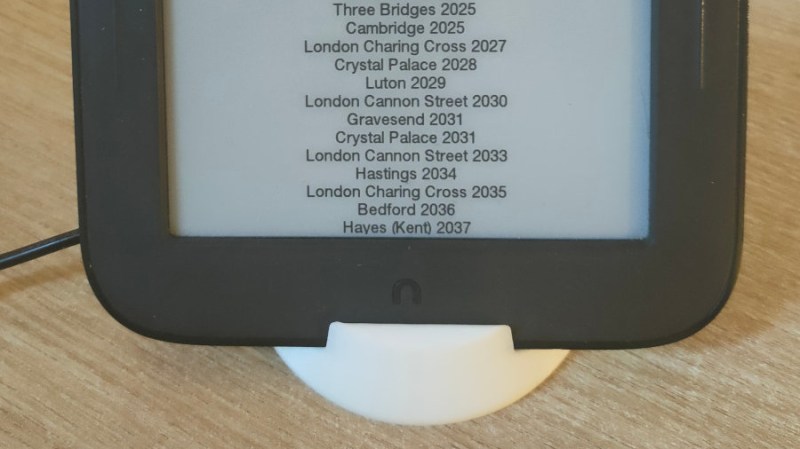In our drawers, there’s gonna be quite a few old devices that we’ve forgotten about, and perhaps we ought to make them work for us instead. [Jonatron] found a Nook Simple Touch in his drawer – with its E-ink screen, wireless connectivity and a workable Android version, this e-reader from 2011 has the guts for always-on display duty. Sadly, the soft touch covering on the back disintegrated into a sticky mess, as soft touch does, the LiIon battery has gone flat, and the software support’s lackluster. Both of these are likely to happen for a lot of tablets, which is why we’re happy [Jonatron] has shared his story about this e-reader’s revival.
 The soft touch layer on the back didn’t go away with help of alcohol, but by sheer luck, an acetone bottle was nearby, and an acetone scrub helped get rid of the unpleasant stickiness. The tablet’s charging circuitry turned out to be unsophisticated – the tablet wouldn’t boot from MicroUSB input, and [Jonathan] wired up 5 volts from a USB cable straight into the battery input. Mind you, this might not be advised, as Lithium-Ion battery range is from 3 volts to 4.2 volts and a regulator would be called for, but [Jonatron] says it’s been working just fine.
The soft touch layer on the back didn’t go away with help of alcohol, but by sheer luck, an acetone bottle was nearby, and an acetone scrub helped get rid of the unpleasant stickiness. The tablet’s charging circuitry turned out to be unsophisticated – the tablet wouldn’t boot from MicroUSB input, and [Jonathan] wired up 5 volts from a USB cable straight into the battery input. Mind you, this might not be advised, as Lithium-Ion battery range is from 3 volts to 4.2 volts and a regulator would be called for, but [Jonatron] says it’s been working just fine.
Usually, you could just put a webserver on your local network and serve a page with useful information, adding code to refresh the page periodically – but the Nook’s browser didn’t support automatic refreshes. Not to be stopped, [Jonatron] wrote an app for the Nook’s Android install instead; rooting was required but went seamlessly. The Android install is old, and Android Studio for it is no longer downloadable, so he used an older development toolkit somehow still available online. There’s still a small Python-written webserver running on a spare Pi, conditioning the data for the app to fetch. Following best hacker traditions, both the app and the server are open-sourced! With help of a 3D printed stand, this tablet now displays train departure schedules – perfect application for an old e-reader like this.
Got a Nook Simple Touch in a drawer? Now you know you can easily convert it into a hackable E-ink display! We’ve seen numerous tablet restorations before, replacing charger ICs and eMMC drives, turning them into videophones to chat with our relatives and smart home controllers, and there’s even repair databases to help you in your revival efforts. We’ve been getting quite a few projects like these in our last Hackaday Prize installment, Hack It Back, and we hope to see more such rebuilds for our Wildcard round!















i found a “long lost” Nook in my daughter’s bedroom a couple of months back. It responded after having power attached.
Still have mine. One the battery swelled. The other required that “special” cable, and even with it was flaky getting it to charge. The last is one of the first E-ink Nooks without the modem.
I still use mine as an e-Reader, as it’s the last one that had an SD card slot. I’ve replaced the battery, which is easy for the average hackaday reader. Still works great, despite no backlight.
I seem to remember that the Nook needed a “special” USB cable to charge. It was just a bit longer than normal and destroyed other devices with the flex.
Not for Nook Simple Touch. It will charge with regular micro USB cable. There is a single cable for Nook (Color, I think) but it is only adding some functionality (an LED). It won’t prevent you from charging it.
Ohhhhh… those are *train departure times*… Gotcha. I thought they were upcoming event dates for the next decade plus.
Ick, two columns please, center justified is suitable for the menus in French restaurants and practically nothing else. :-P
The old fashioned train.schedules in the stations used flip letter displays and they made a lovely noise when they changed. When a train departed, and the whole thing scrolled the noise went on for a while. The modern digital replacement still makes the same simulated sound when it changes. It is your cue to glace at the sign to see if your train is boarding yet.
I would not consider the process “easy”. But regarding the sticky back. I had great luck with electrical tape. Just cut a few strips of electrical tape and mask the back. For some reasons, the plastic-turned-sticky material bonds really well with the not-so-sticky electrical tape.
I really would prefer if recycling centers started paying consumers for old electronics. They weren’t built with long term usage in mind, and it’s usually a lot of pain and compromises needed to get EOL kit back into a usable state. And fixing devices is usually cost comparable or worse than simply buying new again, so many consumers continue buying new and repair shops struggle to stay afloat.
Personally I don’t enjoy having to reverse engineer every gadget that goes obsolete in order to keep using it. If I need repair guidance for a car or an appliance I can usually buy or download the complete factory repair manual, and parts allowing I can keep it running for many years to come. But if I want repair guidance for any ARM-based portable device my only options are personal experience, search engines or iFixit. Parts are mostly nonexistent except through other salvaged units, and I would assume manufacturers probably don’t even bother to write service manuals for most of their low end products.
It’s good to see people repurposing what normally goes to waste, but not as good as having a right to repair and readily available recycling options. Some old electronics are timeless, but most of them are forgettable, also-ran, mass-produced junk, and we would all be better served by finding a way to recycle the mountains of unwanted widgets, rather than removing features and then chucking them into a landfill.
I would like to see more local “share te repair” offers, where local hackers can pickup stuff to give it second use.
But don’t a lot of hackerspaces have the problem of “stuff that someone thinks could be useful if they were to spend the time to work on it”?
Freecycle groups used to be good for that, but they got kinda swamped by “gimme gimme” types and choosy beggar types that just turned everyone off. IDK why the choosy beggar types were even on those groups, but they would rant and rage and throw names and accusations if anything had the slightest scratch, how dare people offer such garbage and they somehow ruined thier kids birthday and all kinds of crap. The gimme gimme types wanted every last thing, and were always posting fake sob stories (against rules) about why they in particular should have it. But one week they had three toddlers, the next week they had 3 teens, and they drove a toyota, a ford, a honda, etc if they were car parts… I reckon they were eBay sellers/scammers.
A simple first step is require portable consumer electronics to have user replaceable batteries. Many electronics become useless because their battery no longer holds a charge. My 20 y.o. MP3 player still fully function because it uses AAA battery. But a y.o. smartphone is a paper weight. I wish there is a higher capacity, a good form factor rechargeable battery standard than the dated AA/AAA. Something rectangular that fits into today’s electronics trend.
I got a Nook S T for very cheap off eBay a few years ago. I had to flash the US firmware, as the original UK support was discontinued and caused a huge battery drain, probably through wakelock trying to ping load the storefront or so. I found the firmware online and easily flashed it.
I keep it disconnected and sideload my exported ebooks and still works fine as an ereader without any distraction. I could root, flash custom stuff and so on, but in the end that’s the opposite of what I wanted: a device where technology and software isn’t a distraction.
The battery isn’t 100% fresh and I did have to open the back and push the connector in place as it’s flimsy by design, but I think that’s still serviceable as long as your main focus is to read.
Regulated? Whack a diode in it, ~4.3V is probably close enough esp. if it works with 5V. It’s not like this is critical. :D
Yeah you’re most likely right! ^^